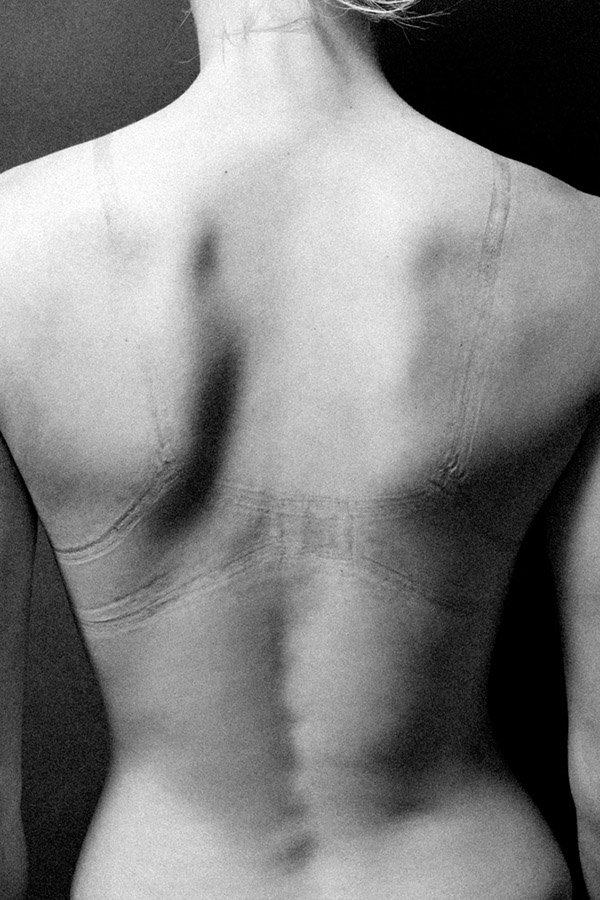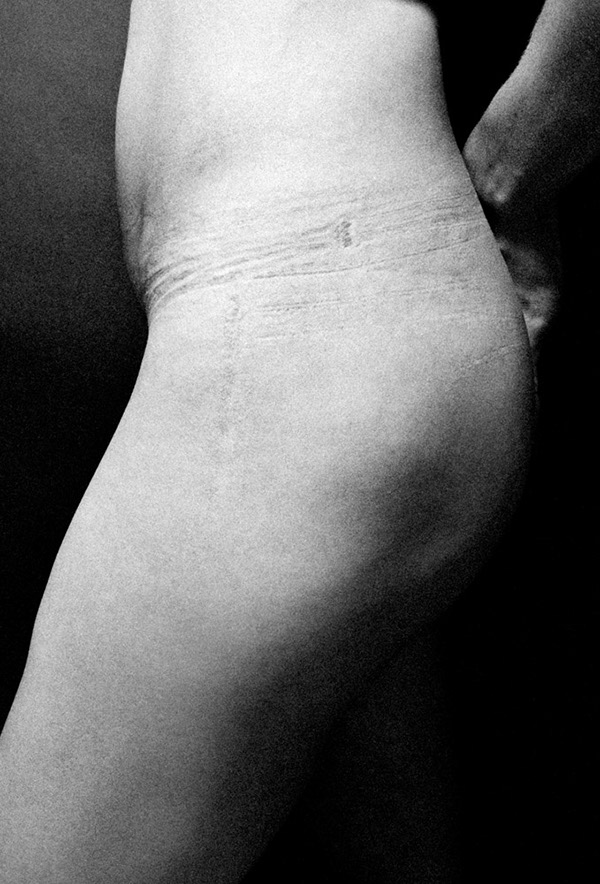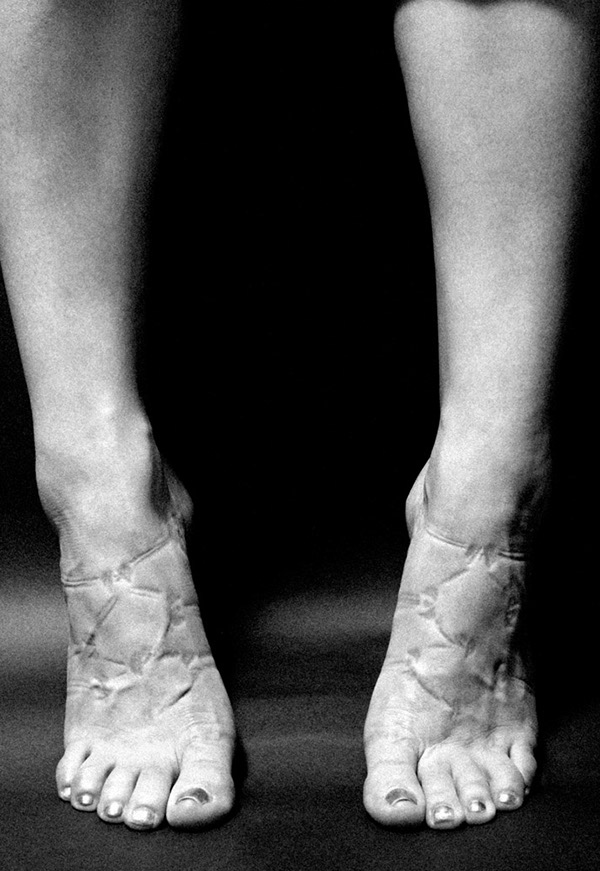In conclusion it is evidently clear that body image is an increasing issue for both men and women. We are becoming increasingly influenced by the media and the images that we are bombarded with day in and day out. Magazines, T.V and social media all play key parts in the way we feel about and see our bodies. Negative body image is becoming an ever growing issue, especially among teenagers and young adults. As mentioned in the previous post there are ways in which we can help improve our attitude and feelings regarding body image, and this in turn will help self esteem and confidence too. Hopefully individuals will stop wanting, or needing, to appear like the men and women that are shown to us after being digitally enhanced and ‘Photoshopped’ on magazines and T.V. We need to stop following and worshiping these unobtainable images and learn to love our bodies the way they are.
Category: Body Image
Developing a Healthy Body Image
There are some steps that can be taken towards both improving body image and self esteem. These tips aren’t going to instantly change the way one feels about their body, but can definitely be a step in the right direction.
1. Get to know your body
This is an important step in learning to accept your body, but a lot of people just avoid who they are and what they look like as they simply do not want to see it. People need to learn to love their bodies, and accept who they are. Try on new outfits, or a new hairstyle. This will not only improve how you feel about your body but your self esteem too. Try and find things that you actually like and admire about your body and focus on these to help build your confidence.
2. Stop comparing yourself to others
Comparing yourself to others will always lead to the desire of wanting to become something unachievable. It takes away the uniqueness of what is truly you. People tend to notice all their flaws and none of their positive attributes when contrasting themselves to other people. Not much can be gained by sitting comparing yourself to others. Your self worth is not judged by your weight or your appearance, so don’t lower your dignity.
3. Focus on the good things
Focusing on positive things in your life can help both your mood and and your confidence. Focusing on family, friends, a hobby or something positive can reflect on your mood and overall state of mind. Taking up a new hobby can lead to meeting new people and achieving goals which in turn creates happiness and confidence.
4. Appreciate what your body was made for
We were created to do and achieve things, our bodies were made to help carry us and survive. Without our bodies we wouldn’t be able to run, dance, laugh or cry. Learning to appreciate our body and not judge ourselves on size or appearance will slowly help to creative an overall more positive body image.
5. Separate feeling bad from feeling fat
If we have a bad day, we can find it easy to get our feelings mixed up with the view of our bodies. You may feel down and then blame this on your weight and feel ‘fat’ and ‘ugly’. People can also feel ‘fat’ after eating a large meal, but this doesn’t mean they are. It is merely a state of mind. Changing this attitude can slowly help us to accept our appearance and self worth.
‘Beauty is a state of the mind, not a state of your body’ (Nationaleatingdisorders.org, 2015).
References
Nationaleatingdisorders.org, (2015). 10 Steps to Positive Body Image | National Eating Disorders Association. [online] Available at: https://www.nationaleatingdisorders.org/10-steps-positive-body-image [Accessed 29 Apr. 2015].
Extreme Russia: Teen Model Factory

Popular DJ and television presenter Reggie Yates most recent documentary ‘Extreme Russia: Teen Model Factory’ was recently broadcast on BBC3, with an outcome of mixed reviews. The programme focused on international model scouts looking to recruit new models in the areas capital Novosibirsk. The first thing we learn is that younger models are favoured, and that girls as young as 13 are auditioning to get selected by various modelling agencies. One girl didn’t make the cut due to her hips being 1cm too wide, and she was also forced to wear heels even though she had a back problem. Many people found this disturbing and somewhat demoralising for the women. It shows the different extremes between cultures, and that these women will do anything they can to try and get a job in the model industry. At one point Reggie says “The lines of right and wrong are just so blurred”, which is exactly what the documentary proves.
Children begin learning to model between the ages of 4 and 5, and learn to walk, pose and apply makeup in specially designed classes. The class he enters are children aged between 6 and 12, and you can instantly see how experienced and knowledgeable they are about modelling. He also speaks to a model who began when she was 14, and she discusses how many models travel abroad but due to lack of money have to turn to prostitution. The extreme lengths these young people have to go to just to find a job to provide for their families is pretty remarkable.
There were mixed reviews on the programme, many finding it disturbing and uncomfortable to watch. Having girls as young as 13 standing in their underwear in front of men doesn’t sound quite right. Overall the documentary gave a fascinating in depth look into the lives of those struggling to make it in an industry where there seems to be no boundaries, and the women will do anything they can to make it in this world.
https://twitter.com/_nialucy/status/590987124213702656
https://twitter.com/eva_wakeford/status/592783979595636736
https://twitter.com/Shhhaanx/status/592816550337454080
The full documentary can be found at : http://www.bbc.co.uk/programmes/b05sj8zx
References
BBC, (2015). Teen Model Factory, Reggie Yates’ Extreme Russia – BBC Three. [online] Available at: http://www.bbc.co.uk/programmes/b05sj8zx [Accessed 29 Apr. 2015].
“Women are dying to be thin”

The above info-graphic shows some statistics relating to the fashion industry and body image. It shows increasing changes in the fashion industry over time, and also the effects that the media has on women and body image. Pretty much all the facts in this info graphic show unhealthy material. A staggering 69% of women say that models in magazines influence their idea on the ‘perfect’ body shape, and 80% of women who answered a people magazine survey said that images of women on T.V and in the movies make them feel insecure. All these negative thoughts can lead to low self esteem and therefore eatings disorders as spoken about in the previous post. Many people with eating disorders don’t actually have a realistic sense of what they’re body looks like, and this therefore leads to an unhealthy obsession with their weight and image. The worshipping of these fashion models and actors and actresses in movies is clearly a problem that needs to be addressed, and hopefully over time women will soon realise they don’t need to reach these unobtainable expectations that the media are throwing at us.
References
Radarprogrammes.com, (2014). Women are dying to be thin. [image] Available at: http://upw-prod-images.global.ssl.fastly.net/nugget/52f271fb27e6187060000010/attachments/women-are-dying-to-be-thin-900-3532d3d45b2ce0021c762578ee41a157.jpg [Accessed 29 Apr. 2015].
Eating and Exercise Disorders
Negative body image and body dissatisfaction can lead to a number of health problems such as under eating and over exercising. These can be linked to low self esteem issues and the want and need to become skinnier and more attractive. 90-95% of eating disorders occur among women and this can be caused by the idealisation of being thin in todays society (Powers, 2015). Media is one of the largest contributors to body dissatisfaction due to people being bombarded with images of perfect but unobtainable men and women. This can cause obsessiveness over trying to loose weight and become like these people in the magazines and on T.V. But with use of photoshop and enhancements it just isn’t possible.
Eating disorders
Mentalhealth.org.uk states that 1.6 million people in the UK have an eating disorder. The most common of these being anorexia and bulimia, which not only affect physical but mental health too. Anorexia is a mental health disorder in which symptoms include not eating enough, loosing weight rapidly, being conscious about calorie intake and having worries over food in general. It causes people to compare themselves to others and become obsessive in what not only they look like, but others too. Anorexia can lead to depression, feeling weak, not being able to get pregnant, lack of sleep and difficulty concentrating (Youngminds.org, 2015). Many women use their weight as a measure of self worth, so things such as anorexia can be a way to get in control of their body and increase self esteem. Bulimia is also another common mental health problem, similar to that of anorexia it is about being in control of the body and the focus on being satisfied with overall body image. Bulimia is when an individual binge eats on fattening foods, and then makes themselves sick or uses laxatives to get rid of the foo due to feeling guilty. This can lead to health problems such as corrosion of teeth, dehydration, heart problems, excessive exercise, muscle spasms and weight loss. It is highly based on thoughts and feelings as people are extremely secretive about what they are doing.
It is important to get help when facing any of these mental health problems. Being dissatisfied with your body and developing unhealthy eating and exercise habits can lead to a long list of health problems. Increased awareness of these issues may help prevent individuals from comparing themselves to others, unrealistic models and celebrities.
References
Mentalhealth.org.uk, (2015). Eating Disorders. [online] Available at: http://www.mentalhealth.org.uk/help-information/mental-health-a-z/e/eating-disorders/ [Accessed 29 Apr. 2015].
Powers, P. (2015). Eating Disorder Services: What is the Link Between Exercise and Eating Disorders?. [online] Eatingdisorders.org.nz. Available at: http://www.eatingdisorders.org.nz/common-questions/what-is-the-link-between-exercise-and-eating-disorders/ [Accessed 28 Apr. 2015].
Youngminds.org.uk, (2015). What is Anorexia – Anorexia Support – YoungMinds. [online] Available at: http://www.youngminds.org.uk/for_children_young_people/whats_worrying_you/anorexia/what_is_anorexia [Accessed 29 Apr. 2015].
Identity online
People go online for a number of reasons, whether it be to socialise with friends or to find information, but with the increasing development of technology we have more choice than ever with what we can do online. For example on social media sites people are increasingly using Photoshop and other photo editing software to warp their images in someway. Being able to digitally enhance body shape is a problem that can be deceiving and allows people to pretend to be something they’re not. This can cause misrepresented perceptions of what we are actually meant to look like – which in the end just creates a vicious circle. ‘Selfies’ have become a popular trend, as you choose the best angle, lighting and setting to take your photo and can upload it to your social media account. This has become peoples way of looking for approval online – to be told that they look attractive or sexy is at the forefront of everyones minds. According to YouthNet.org ‘75% of young people claimed they could not live without the internet while 86% loved how new technology helps them communicate with people.’ this shows that an increasing number of young people are using the internet, and along with this people are developing ways of changing who they are, and what they look like online. The following link shows a video starring Youtuber and blogger Cassey Ho. The video outlines body shaming, and how speaking about someone else’s appearance can effect the way they see themselves. It shows how easy it is to change our appearance using technology, but if only it could be this simple in real life.
Are you beach body ready?
Recently the company ‘Protein World’ released an advertisement in tube stations in London. The ad shows a tall, blonde women standing in her bikini, with the caption ‘Are you beach body ready’ written beside it. This instantly sparked up controversy on social media sites, with people retaliating and calling the ad ‘discriminating’. There has already been a petition begun to take down the advertisements named ‘Remove ‘Are You Beach Body Ready’ Advertisements’. The petition states “Protein World is directly targeting individuals, aiming to make them feel physically inferior to the unrealistic body image of the bronzed model, in order to sell their product (Change.org, 2015). People took to social media to show their disapproval with the advertisement and were tweeting pictures and hash tagging #beachbodyALREADY.
“Real Men”
In September 2013 a popular newspaper called The Sun teamed up with photographer Jenny Francis to take photos of male readers to recreating popular advertisement photos for male models. As Dove launched their Real Beauty campaign showing ‘real women’ (as mentioned earlier in the blog), this was a chance for men to have their say. Now, we know that most models have been airbrushed in some way to enhance their chiseled muscles or darken their already unnatural tan, but what would it be like to see real, natural men doing the modelling? Well, The Sun got four everyday men to stand in the same underwear, in the same poses as the male models and put the photographs side by side. Here are the products below:



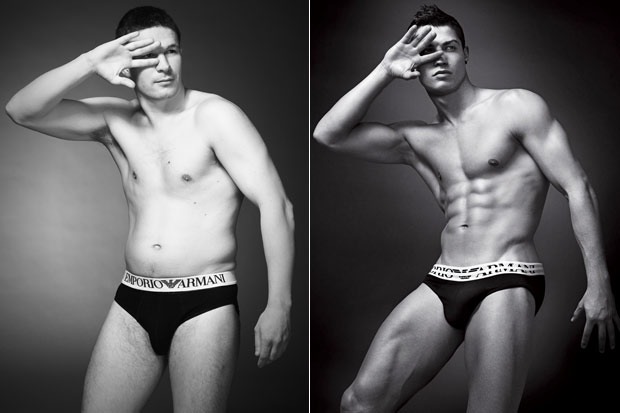
Although these images are just a bit of fun, hopefully they have and will continue to encourage men to accept their bodies and show that not everybody is the same. Read more
Does body image affect men?
The short answer is yes.
It’s not just women who suffer from dissatisfied body image and low self esteem – it’s men too. Increasingly, magazines, social media sites and advertisements are using celebrities and toned men with perfect physique to promote products. Being exposed to these unrealistic images in the media can lower self esteem and cause increasing issues regarding appearance. Only over the past few years has there been an increase in larger women used in the media, to advertise products and promote companies. But it seems there has been a lack of plus sized models for men (Lovejoy, 2014). The following quote is taken from an article written by Dennis Campbell for The Guardian.
“More than four in five men (80.7%) talk in ways that promote anxiety about their body image by referring to perceived flaws and imperfections, compared with 75% of women. Similarly, 38% of men would sacrifice at least a year of their life in exchange for a perfect body – again, a higher proportion than women” (Campbell, 2012).
This staggering figure indicates just how much men are affected, and that they also face problems with body image and confidence. Marketers obviously can increase sales with skin care and weight loss products through using men with perfect skin and chiseled bodies, but it is clear this has a large effect on men. Not only that – but women love the way these men look, which worsens the problem even further. It has become a trend for men to go to the gym and get 6 packs and toned muscles, and a number of these men have probably been influenced by online media. When people feel too fat or too thin – it can lead to unhealthy things. Eating disorders and over exercising are just a couple of the many problems men (and women) face in the bid to create a satisfying body image. Read more
Clothing and Body Image
We live in a culture that is becoming increasingly concerned with looking youthful, beautiful and slim, and we therefore perceive ourselves differently from how we actually look to how we want to look. Clothing is an extension to the body and what we wear expresses our final image and how we want to be perceived. Individuals use clothing and fashion to express their physical image and to make them feel better about themselves. Many people can relate to wearing a bad outfit and feeling uncomfortable all day, as it can lower confidence and . ‘Fashion trends’ are normally for the style rather than the fit, but it can also help with an individuals confidence as clothing can represent ones self. Different companies use models to illustrate clothing through different media channels, and many of these models are an unrealistic interpretation of your ‘average’ man or woman. Everybody has a different perception of an ‘ideal’ body, and seeing these models in magazines and on TV adverts encourages people to buy the clothing advertised to achieve this ideal image. We’ve all been there when we try on a piece of clothing thats too tight, but just refuse to go a size up as we don’t want to believe we are that size. Justin Alexander Bartels created a photo series called ‘Impression’, which focuses on clothes women think they should wear or what other people want them to wear.
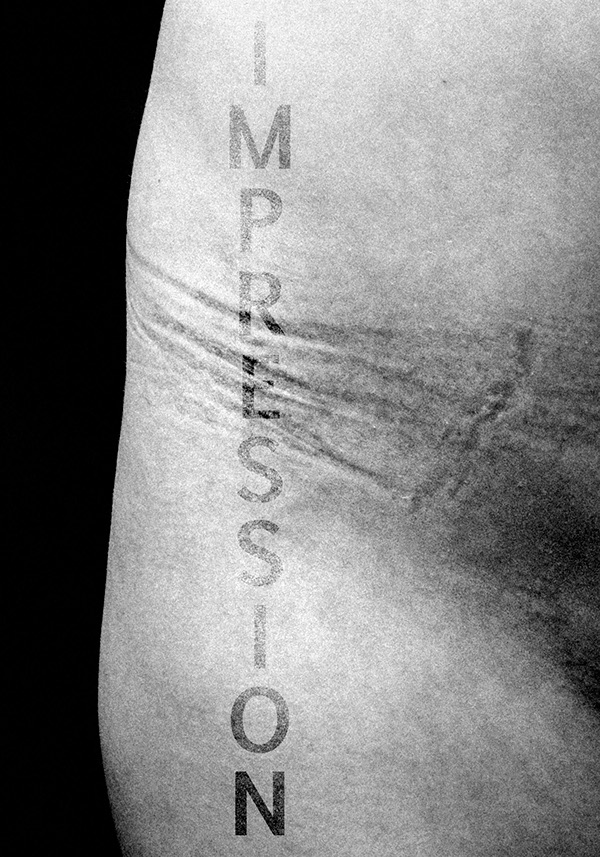
Below are a few images from the series:
